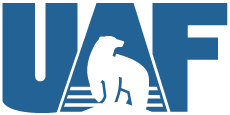
Office Hours
Tuesday & Thursday
10:00–11:30 am
232 Irving II
Lara Horstmann
Chair, Department of Marine Biology
Professor
Fisheries Ecology
Marine Biology
Marine Mammals
College of Fisheries and Ocean Sciences
232 Irving II
Fairbanks, AK 99775-7220
907-474-7724
907-474-7204 (fax)
lara.horstmann@alaska.edu
- Anthony Blade
- Chelsea Campbell
- Brett Carrothers
- Soren George-Nichol
- Hanna Hellen
- Chloe Kotik
- Sonia Kumar
- Jordan O'Connor
- Noelle Picard
- Natalie Rouse
- Charlotte Springer
PUBLICATIONS LIST HERE
- Fisheries Ecology
- Marine Biology
- Marine Mammals
I am interested in broad-scale marine mammal ecology. Feeding ecology in particular
is a keystone piece of information to understand adaptation potential of marine mammals
and challenges that may arise. Dietary limitations can affect reproductive success,
compromise immune function, change exposure to new pathogens (i.e., parasites, contaminants),
and can therefore not only limit marine mammal population growth, but also potentially
introduce new threats to humans depending on them as a subsistence resource.
I focus my research on Arctic marine mammals, because (1) they are of cultural and
nutritional importance to subsistence users, (2) the Arctic is undergoing noticeable
change, and (3) planned oil and gas development in this habitat.
I am also working on a fish parasite, Ichthyophonus hoferi, in Chinook salmon, and its potential impact on pre-spawning mortality and fecundity.
- Microplastics in northern fur seals on St. Paul Island
- Microplastics in subsistence harvested bowhead whale tissues
- Microplastics and phthalate concentrations in subsistence harvested Chukchi Sea beluga whales
- Host and microbial contributions to wax ester lipid digestion in Arctic whales
- Maternal transfer of microplastics across the placenta in subsistence harvested spotted seals


